
A myosin light chain is a light chain (small polypeptide subunit) of myosin. [1] Myosin light chains were discovered by Chinese biochemist Cao Tianqin (Tien-chin Tsao) when he was a graduate student at the University of Cambridge in England. [2]

A myosin light chain is a light chain (small polypeptide subunit) of myosin. [1] Myosin light chains were discovered by Chinese biochemist Cao Tianqin (Tien-chin Tsao) when he was a graduate student at the University of Cambridge in England. [2]
Structurally, myosin light chains belong to the EF-hand family, a large family of Ca2+- binding proteins. MLCs contain two Ca2+ - binding EF-hand motifs. MLCs isoforms modulate the Ca2+of force transduction and cross-bridge kinetics.
Myosin light chains (MLCs) can be broadly classified into two groups:
Essential and regulatory MLCs have molecular masses of 22 and 19 kDa, respectively. Structurally, MLC2 contains a serine residue that is lacking in MLC1. The presence of this amino acids allows the regulation of the conformational changes (from compacted to an elongated form) by a Ca2+-mediated phosphorylation mechanism. MLC1, in contrast with MLC2, has a N-terminal sequence able to bind actin, contributing to force production.
MLCs are structurally and functionally distinct from myosin heavy chains (MHCs). Nevertheless, the association of MLCs with the neck region of MHCs is necessary for the assembly of the macromolecular complexes that result in the functional motor protein, myosin. The interaction of MLCs with the α-helical neck region of MHC molecule stabilizes the complex .
To this day, eight genes encoding for MLCs in mammalians have been described; several isoforms have also been characterized. Four out of the 8 genes are MLC1 genes, whilst the remaining are MLC2 genes. [3]
MLC1 genes:
MLC2 genes:
Other proteins and enzymes related to MLC function have been described. Among them are, for example, MYL6B, MYLIP, MYLK, and MYLK2,
Several diseases have been associated with mutations in the genes encoding for myosin light chain proteins. The majority of these diseases are cardiomyopathies, such as hypertrophic (HCM) or dilated (DCM) cardiomyopathy and sudden cardiac death. Mutations in MYL2 and MYL3 have been reported for these diseases. [4]
One study, published in 2012, found that valvular myosin 'LC1', in the hearts of three patients with valvular heart diseases, had structures similar to those of valvular myosin of people who were in their early stages of DCMP and HCMP. The researchers hypothesized that the structure distortion of these valvular myosin were due to adaptational changes by the body in an attempt to improve the functioning of the heart. [5]
Myosin light chain kinase (MLCK) inhibitors are one of the few peptides that can cross the plasma membrane relatively quickly. Under stressful conditions, MLCK's in the human body promotes increased permeability of microvessels. It is thought that MLCK phosphorylates endothelial myosin, leading to cell contraction. This reaction prevents disengaged cells that are adjacent to one another from reestablishing connections, thus contributing to the maintenance of the gaps between cells. With their strong ability to cross the plasma membrane with little resistance from the cell, along with their specificity for a single target-substrate, MLCK inhibitors can potentially evolve into novel antiedemic drugs. [6]
MYL9 , MYL12a, and MYL12b (MYL9/12) have been described as new functional interaction partners with CD69 in the pathogenesis of inflammation of the airways.
A novel mechanism of activated T cell recruitment into inflammatory tissues has been proposed, known was "CD69/Myl9/12 system". The proposed mechanism state that "Myl9/12-containing net-like structures are created in inflammatory vessels, which play an important role as a platform for recruitment of CD69-expressing leukocytes into inflammatory tissues. T cells that are activated in the lymph nodes proliferate, down-regulate CD69 expression, and then leave the lymph nodes to migrate into inflammatory sites in an S1PR1-dependent manner." [7]
The proposed mechanisms of action of CD69/Myl9/12 system are related to the regulation of airway inflammatory processes and thus can prove to be a novel therapeutic target for chronic inflammatory diseases, in general. [8]

Smooth muscle is an involuntary non-striated muscle, so-called because it has no sarcomeres and therefore no striations. It is divided into two subgroups, single-unit and multiunit smooth muscle. Within single-unit muscle, the whole bundle or sheet of smooth muscle cells contracts as a syncytium.
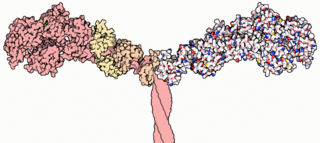
Myosins are a superfamily of motor proteins best known for their roles in muscle contraction and in a wide range of other motility processes in eukaryotes. They are ATP-dependent and responsible for actin-based motility.
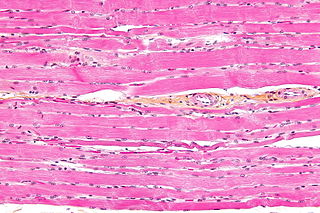
Striated muscle tissue is a muscle tissue that features repeating functional units called sarcomeres. The presence of sarcomeres manifests as a series of bands visible along the muscle fibers, which is responsible for the striated appearance observed in microscopic images of this tissue. There are two types of striated muscle:

Titin is a protein that in humans is encoded by the TTN gene. Titin is a giant protein, greater than 1 µm in length, that functions as a molecular spring that is responsible for the passive elasticity of muscle. It comprises 244 individually folded protein domains connected by unstructured peptide sequences. These domains unfold when the protein is stretched and refold when the tension is removed.
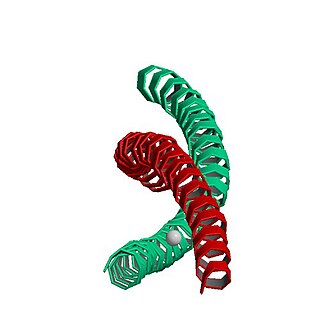
MYH7 is a gene encoding a myosin heavy chain beta (MHC-β) isoform expressed primarily in the heart, but also in skeletal muscles. This isoform is distinct from the fast isoform of cardiac myosin heavy chain, MYH6, referred to as MHC-α. MHC-β is the major protein comprising the thick filament in cardiac muscle and plays a major role in cardiac muscle contraction.

Telokin is an abundant protein found in smooth-muscle. It is identical to the C-terminus of myosin light-chain kinase. Telokin may play a role in the stabilization of unphosphorylated smooth-muscle myosin filaments. Because of its origin as the C-terminal end of smooth muscle myosin light chain kinase, it is called "telokin".
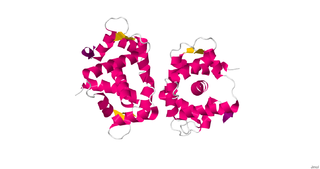
Myosin light-chain kinase also known as MYLK or MLCK is a serine/threonine-specific protein kinase that phosphorylates a specific myosin light chain, namely, the regulatory light chain of myosin II.

Myosin regulatory light polypeptide 9 is a protein that in humans is encoded by the MYL9 gene.

Myosin-10 also known as myosin heavy chain 10 or non-muscle myosin IIB (NM-IIB) is a protein that in humans is encoded by the MYH10 gene. Non-muscle myosins are expressed in a wide variety of tissues, but NM-IIB is the only non-muscle myosin II isoform expressed in cardiac muscle, where it localizes to adherens junctions within intercalated discs. NM-IIB is essential for normal development of cardiac muscle and for integrity of intercalated discs. Mutations in MYH10 have been identified in patients with left atrial enlargement.

Myosin regulatory light chain 2, ventricular/cardiac muscle isoform (MLC-2) also known as the regulatory light chain of myosin (RLC) is a protein that in humans is encoded by the MYL2 gene. This cardiac ventricular RLC isoform is distinct from that expressed in skeletal muscle (MYLPF), smooth muscle (MYL12B) and cardiac atrial muscle (MYL7).

Myosin heavy chain, α isoform (MHC-α) is a protein that in humans is encoded by the MYH6 gene. This isoform is distinct from the ventricular/slow myosin heavy chain isoform, MYH7, referred to as MHC-β. MHC-α isoform is expressed predominantly in human cardiac atria, exhibiting only minor expression in human cardiac ventricles. It is the major protein comprising the cardiac muscle thick filament, and functions in cardiac muscle contraction. Mutations in MYH6 have been associated with late-onset hypertrophic cardiomyopathy, atrial septal defects and sick sinus syndrome.

Myosin essential light chain (ELC), ventricular/cardiac isoform is a protein that in humans is encoded by the MYL3 gene. This cardiac ventricular/slow skeletal ELC isoform is distinct from that expressed in fast skeletal muscle (MYL1) and cardiac atrial muscle (MYL4). Ventricular ELC is part of the myosin molecule and is important in modulating cardiac muscle contraction.

Atrial Light Chain-1 (ALC-1), also known as Essential Light Chain, Atrial is a protein that in humans is encoded by the MYL4 gene. ALC-1 is expressed in fetal cardiac ventricular and fetal skeletal muscle, as well as fetal and adult cardiac atrial tissue. ALC-1 expression is reactivated in human ventricular myocardium in various cardiac muscle diseases, including hypertrophic cardiomyopathy, dilated cardiomyopathy, ischemic cardiomyopathy and congenital heart diseases.
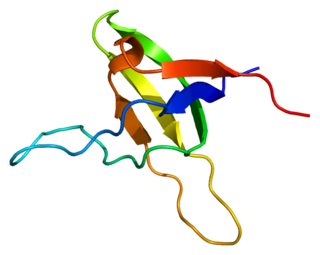
Obscurin is a protein that in humans is encoded by the OBSCN gene. Obscurin belongs to the family of giant sarcomeric signaling proteins that includes titin and nebulin. Obscurin is expressed in cardiac and skeletal muscle, and plays a role in the organization of myofibrils during sarcomere assembly. A mutation in the OBSCN gene has been associated with hypertrophic cardiomyopathy and altered obscurin protein properties have been associated with other muscle diseases.

E3 ubiquitin-protein ligase TRIM63, also known as "MuRF1", is an enzyme that in humans is encoded by the TRIM63 gene.

Myosin light chain 3, skeletal muscle isoform is a protein that in humans is encoded by the MYL1 gene.

Myosin light chain kinase, smooth muscle also known as kinase-related protein (KRP) or telokin is an enzyme that in humans is encoded by the MYLK gene.

Atrial Light Chain-2 (ALC-2) also known as Myosin regulatory light chain 2, atrial isoform (MLC2a) is a protein that in humans is encoded by the MYL7 gene. ALC-2 expression is restricted to cardiac muscle atria in healthy individuals, where it functions to modulate cardiac development and contractility. In human diseases, including hypertrophic cardiomyopathy, dilated cardiomyopathy, ischemic cardiomyopathy and others, ALC-2 expression is altered.

Myosin light chain kinase 3 also known as MYLK3, is an enzyme which in humans is encoded by the MYLK3 gene.

Myosin light chain kinase 2 also known as MYLK2 is an enzyme which in humans is encoded by the MYLK2 gene.
{{cite journal}}: Cite journal requires |journal= (help)